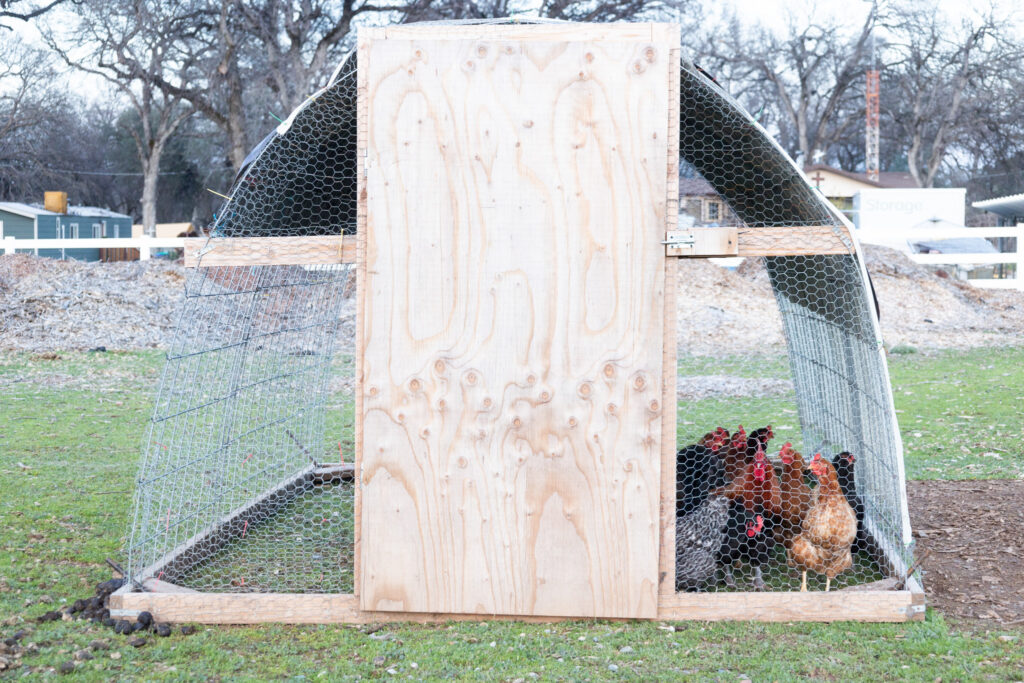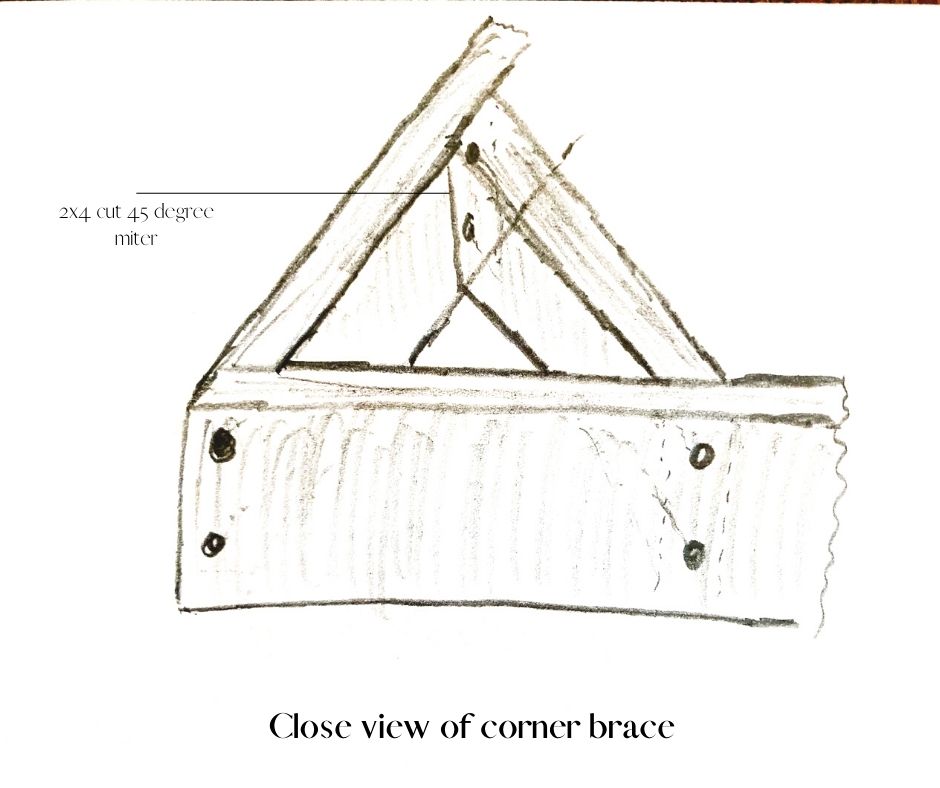Learn how to easily build a hoop chicken coop at home. Your diy hoop coop will keep your flock happy and healthy!

This post contains affiliate links which means I make a small commission at no extra cost to you. See my full disclosure here.
Interest in pasture poultry production has definitely gotten more popular in recent years. Our journey towards managing chickens in the pasture started from wanting to eliminate cleaning a static coop! Turns out it has all kinds of other benefits besides eliminating a dreaded homestead chore.

This style of chicken housing is build without a bottom to the coop which allows the birds to always have access to fresh ground when they are moved regularly. The chickens can forage on plants and insects all while being protected from predators. We sometimes also use a small A-frame style chicken tractor that Grey designed as well when we need the chickens in smaller areas and moved closer to the house. Both work great for us because they are in a safe zone that doesn’t need to be cleaned!
Here’s how we build our hoop coop!

Pros of a hoop chicken coop
- Low cost. It is a relatively inexpensive option for housing poultry on pasture.
- Easy to move. The finished hoop pen is relatively lightweight.
- Strong. Despite its light weight, the frame is strong enoughto handle daily moving.
- Allows a person to stand up. The pen is built with two cattlepanels and has a ceiling of about six feet.
- Provides ventilation options. The adjustable side curtain allowsfor different levels of ventilation as required for the changing weather conditions.

Cons of a hoop chicken coop
- Heavier than other models of chicken tractor.
Materials you will need to build a hoop coop
- (3) 8′ pressure treated 2×4
- (2) 12′ pressure treated 2×4
- (3) 4’x16′ cattle panels
- 3.5′ construction screws
- 1′ screws
- fencing staples
- sheet metal ties
- galvanized plumbers tape or sheet metal ties
- Tie wire (bailing wire)
- heavy gauge chicken wire
- (4) door hinges
- (1) Gate latch (door latch)
- 1 sheet plywood
- zip ties
- heavy duty tarp

Tools you’ll need for a hoop chicken coop
- Tape measure
- Speed/framing square
- Pencil
- Impact gun/cordless screwdriver
- Tie pliers
- Skill saw
- Hammer
- Staple gun
- Bolt cutters

How to build a hoop chicken coop



1. Base Frame
Start by building the rectangular 2×4 frame (four pieces). We use pressure treated wood for the base frame. Our coops are (8’x 12′ but the same design would work 8’x 8′.)
To build this frame, screw the 2x4s together so they make a rectangular (or square) frame. When the frame is flat on the ground the 2″ face of the lumber contacts the ground and the Frame stands 4″ tall. Screw all the lumber together with 3.5″ construction screws.
To strengthen the frame, cut (4) 2x4s into 16″ long corner supports. Miter each end at 45 degree angles. Screw these supports in the corners of your frame.


2. Build the hoop
Heads up!: this step requires two people.
Then attach the cattle panels. If you are making an 8ft. long coop you’ll need 2 cattle panels. If you plan to make a 12ft. long coop you will need 3 cattle panels. Start on one side, and set the panel to the inside of the frame. Using bolt cutters, cut around the corner braces. Anchor the panels to the frame using fencing staples and sheet metal ties. Bend the panels to form an arch and attach on the inside of the opposite side of the frame. Secure the panels with galvanized plumbers tape or sheet metal ties and screws, on both sides. Tie the panels together every 12-16″ with tie wire.

3. Door Frame
Build the door frame by cutting the (2) 2×4 frame posts to length. They should be sitting on the base frame and go up to the height of the hoop. They should be about 28″ apart. Anchor the side door frame by screwing them to the base frame. Cut the header to length to span between the (2) side posts of the door frame and anchor it into place.
Roughly halfway up the side posts attach 2×4 bracing that spans horizontally from door post to the cattle panel (this adds rigidity and anchor points for your chicken wire.) Anchor the panels to the frame using fencing staples and sheet metal ties
If you already have a door you plan on using rather than cutting a piece of plywood to size–build the frame to fit your door.

4. Door and Latch
You can get creative with the door you choose. An old screen door would work. If you have already built your frame, you can cut a piece of plywood to fit the size of the door frame. Face mount the door to the frame with a pair of hinges. Install the door latch to the opposite side of the door.

5. Back Frame
To build the back frame and hatch, frame with 2×4’s this will give a place for a hatch and stiffen the back of the hoop. Cut the vertical uprights to length and attach by anchoring the hatch door frame by screwing them to the base frame.
Cut the header to length to span between the (2) side posts of the hatch frame and anchor it into place. Roughly halfway up the side posts attach 2×4 bracing that spans horizontally from door post to the cattle panel (this adds rigidity and anchor points for your chicken wire.) Anchor the panels to the frame using fencing staples and sheet metal ties (So far this is a repeat of what you built on the front of the coop.
Now, roughly 2/3 of the way up the “door frame” will frame in the hatch by placing (2) horizontal 2x4s roughly 20″ apart.
Cut and hang with door hinges, the plywood to cover the hatch opening.

6. Chicken wire
We use heavy gauge poultry wire. This helps to prevent predators from entering the coop and contain the chickens. To apply the wire, wrap the chicken wire to the cattle panels over the sides, top, and ends stapling where the wire meets the wooden frames. Tie off to the cattle panels with zip ties or tie wire every food or so. The main thing is to make sure there are no gaps and it is secure and tight.
7. Cover hoop with tarp
Wrap a tarp over the top of the coop by tying with tie wire through the grommets and securing to the panels at the base of either side of the coop. At this point, you’ll want to use stakes to hold the coop in place if you have heavy winds.

8. Plan for nesting boxes, perches, and feeder/water
Because we move our hoop chicken tractor regularly, we chose to keep the nesting boxes, perches, and the feeder/water separate to minimize weight. You could choose to attach these things if you are not moving your coop. When we move the coop we simply remove these items and replace when the hoop coop is in it’s next location.
Tips for managing a flock with a hoop coop
- Use the hoop coop on well-drained pastures. Avoid soggy ground to prevent infections and diseases.
- Place the coop so wind and rain are not entering. Birds do not like sitting in the rain!
- Do not overcrowd you birds. Each bird should maintain at least 8 square feet of space per bird.
- Make sure the birds have fresh, clean water at all times. This goes without being said but keep the water fresh!
- Use proper pasture management. You shouldn’t put chickens on grass that is overly long.
- Move the hoop pen frequently. This will keep the birds in a clean environment, and give the birds plenty of forage to peck through.
- Adjust the coverage of the tarp as required for the weather. You may choose to let the tarp have more airflow in the summer and less in the winter. Observe your birds!

Hoop coop frequently asked questions (FAQ)
How many chickens can you have in a hoop coop?
4 square feet of coop space per bird/8 square feet of run space per bird. So in this style of hoop coop you can comfortably fit 12 birds. Make sure to move them around the pasture every 1-2 days to give them fresh ground to scratch and peck.
What is a chicken hoop coop?
A chicken hoop coop is a construction style that has uses panels arched over a frame to make a lightweight chicken tractor.

Is it cheaper to make or buy a chicken coop?
Typically it is cheaper to build a coop, especially if you get resourceful with where you get materials. If you are short on time or don’t have any building experience it might make sense to buy one.
What material to use for hoop coop?
Hoop coops are typically made from wood, cattle panels, chicken wire, and a tarp for shelter.
Can chickens live in a hoop house?
Yes! As long as they have adequate shelter, clean nesting boxes, roosting space and are taken care of regularly, a hoop coop is a great style chicken tractor.
Related Articles
What is an easter egger chicken?
Water Glassing Eggs: a Step-by-Step Guide
Homesteading for Beginners (What You Actually Need to Know)
101 Homesteading Books You Need at Home

Pin it for later!


Leave a Reply